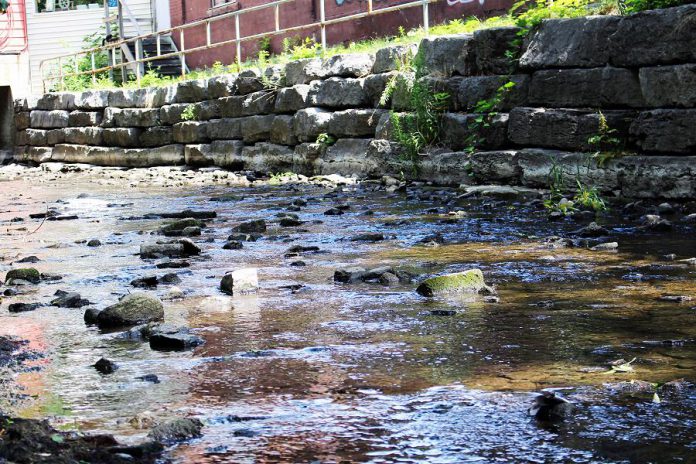Water conservation is on our minds given the local drought we’ve been experiencing. The Otonabee Region Conservation Authority (ORCA) has reported that in 2016, every month except March, has experienced below normal precipitation.
Last week, ORCA declared a Level 2 low water condition for our watershed region. As a result, residents of Peterborough City and County are being encouraged to reduce their water use by 20%.
To better understand how this suggested reduction target will impact our daily routines, we wanted to discuss what a decrease by 20% looks like in practice.
Within the City of Peterborough, the average daily water use is approximately 250 litres per person!
Reducing that amount by 20% means reducing your daily water use by roughly 50 litres.
To put this in perspective, 250 litres is equal to about 1.5 full bathtubs of water. Implementing a 20% water conservation effort would see a reduction of about .25 of a full bathtub.
If reducing water usage by 20% seems like a daunting task, below are some simple changes you can make to easily meet this goal.
- Environment Canada reports that approximately 55% of Canadian household water use occurs during bathroom activities. Showers and baths account for 35% of this usage. Ensuring your shower head is low-flow will help you cut down on water use: a regular shower head uses about 20 litres per minute, while a low-flow uses about 10 litres per minute. So, if you switch to a low flow showerhead, in five minutes you will already have reached the goal of reducing water use by 20%!
- Reducing the amount of time you spend in the shower and filling bathtubs to a lower amount is also suggested. Leanne Bing, who works in water conservation at Peterborough Utilities, explains that you can save up to 1000 litres per month of water if you switch to taking a five-minute shower.
- Leanne also notes that the water from showers and baths can be reused. “You can use a bucket in the shower to catch water while you’re adjusting the temperature, or use your old bath water to water plants,” she suggests.
- Flushing the toilet accounts for 20% of household water use. Switching to a low-flow toilet is a great investment, and will use approximately 6 litres of water per flush compared with older models, which can use up to 13 litres per flush.
- If you have not replaced your toilet with a low-flow version, you can reduce the amount of water per flush by using a product called a Toilet Tummy, also known as a Toilet Tank Bank, or by making a version of this product with a plastic bottle filled with water. They hang inside the back of the toilet and save the water you displace each time you flush the toilet. The amount of water you save with these items depends on your toilet capacity. Testimonials of the product indicate that you can save about 3 litres per flush when using this inexpensive, innovative device.
- Laundry is another household activity that comprises 20% of Canadian household water use. Water can be saved by only washing clothes when they are dirty, ensuring you are running full loads, and skipping the extra rinse.
- Activities that require us to turn the tap on and off — doing dishes, brushing our teeth — also use a lot of water if we leave the tap running when the water is not being used.

These are water conservation tips that can be incorporated into your household routines year-round. In the summer months water usage can increase by 50%, making now a crucial time to implement these practices.
Outdoor water usage is largely responsible for this seasonal increase, and the city has specified a watering schedule to aid in water conservation.
During June, July, and August, if your numerical street address is even, you may water only on even numbered days between 7 a.m. and 10 p.m. If your street address is an odd number, you may water on odd numbered days during the same time period.
An even more water-conscious initiative would be to water your gardens using water stores from rain barrels, and to create a water-wise landscape so that the ground retains more moisture.
“Leaving lawn clippings on the grass will help cool the ground and hold moisture,” Leanne says. “Mowing your lawn less and adjusting the height of the grass to 1.5 to 2 inches will also help because taller grass holds more moisture. Watering spots on your lawn by hand instead of using a sprinkler will cut down on water waste by targeting the areas that need it most.”
A new program established this year aims to recognize members of the community that have taken steps to build a water-wise lawn.
The Water Wise Neighbour: Landscape Recognition Program, initiated by GreenUP and Peterborough Utilities Group, offers the opportunity to nominate a lawn that you believe meets the criteria for being water-wise.
To nominate or to review the criteria for a water-wise lawn, visit GreenUP’s website at www.greenup.on.ca or email Heather Ray, GreenUP’s Water Programs Coordinator, at heather.ray@greenup.on.ca.
These reduction techniques will lessen the strain on our environment during dry times, and also save on our household costs.
Water conservation efforts will be reflected in your water bill. Leaks are a significant, and unnecessary, source of water waste. If you notice spikes on your water bill, and have not been using any more water than you normally do, this could be an indication of a water leak within your household appliances.
Implementing water-wise tactics during this crucial time will help to build these practices into our daily routine, and will establish long-term water-conscious practices that will benefit our environment and aid in our household savings.



























